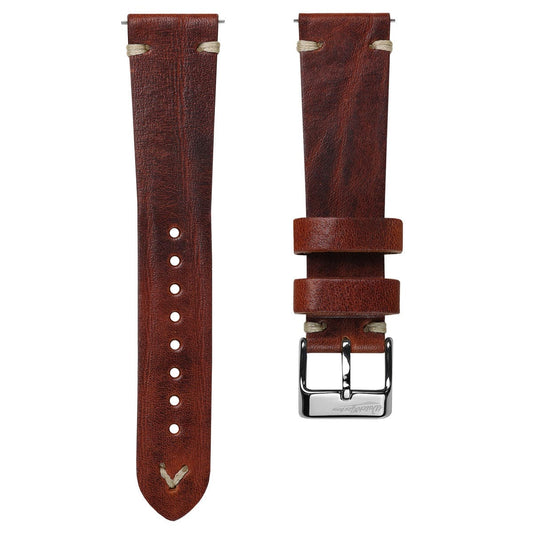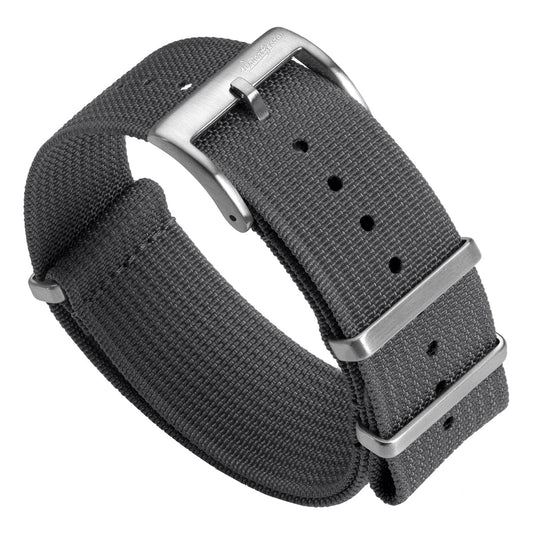What is a Watch Movement?
It’s the ticking heart, or the engine if you like, of a timepiece. It is typically a quartz movement (battery-powered) or a mechanical movement (self-winding or manual-winding). There’s no shortage of watch movements out there; some are the well-known, mass-produced ETA and Sellita movements, while others are created in-house by the watch brand themselves. Today, we’ll be exploring some of the most popular watch movements around and explaining some of the benefits of each.
 Omega-Speedmaster-3861-Caseback - Credit WatchGecko
Omega-Speedmaster-3861-Caseback - Credit WatchGecko
ETA Movements
A Brief History of ETA
For decades, one of the leaders of Swiss-made movement manufacture has been ETA. The company, originally known as Eterna, was first founded in 1856 in Grenchen, Switzerland by Urs Schild and Joseph Girard. The watch movement factory did fairly well at the beginning of its history before eventually struggling due to the economic and production consequences of World War I. To survive, they partnered with Fabrique d’horlogerie de Fontainemelon (FHF) and Adolphe Michel SA (AMSA) to form Ébauches SA.
Under this new name, the company became one of Switzerland’s largest producers of watch movements and ébauches (semi-assembled movements). The latter allowed watch brands to tailor the movements to their own stylings, such as adding an oscillating rotor engraved with their logo. Following the Great Depression in 1929, Ébauches SA and several other Swiss watch movement companies had to strategize again, and eventually, the ASUAG (Allgemeine Schweizerische Uhrenindustrie AG) was formed, partly funded by the Swiss government to help secure the country’s leadership in movement manufacture. Before Eterna joined the ASUAG, the company was split into two: Eterna became a watchmaker while their movement-making division was renamed to ETA SA.
From this moment on, ETA SA became one of the first and only manufacturers to create automatic watch movements. This allowed them to grow into one of the most respected Swiss movement makers in the country. In 1948, ETA even established their own watchmaking school to train horologists looking to learn about the production of movements. They also innovated the ball-bearing mechanism into their automatic winding movements. Today, ETA is part of the Swatch Group, one of the world's largest watch conglomerates. Their widespread use has contributed to the popularity of Swiss-made watches and allowed smaller micro-brands to access high-quality movements without having to develop their own in-house.
Popular ETA Movements
ETA 2824-2
 ETA 2824-2 Movement - Credit WatchGecko
ETA 2824-2 Movement - Credit WatchGecko
- Regular price
- $128.00 CAD
- Regular price
-
- Sale price
- $128.00 CAD
- Unit price
- per

- Regular price
- $128.00 CAD
- Regular price
-
- Sale price
- $128.00 CAD
- Unit price
- per

- Regular price
- $128.00 CAD
- Regular price
-
- Sale price
- $128.00 CAD
- Unit price
- per

This may be the definitive Swiss mechanical watch movement, used widely by watch brands all over the world. The ETA 2824-2 is currently in ETA’s Mescaline range and is available in four movement grades (Standard, Elaboré, Top, and Chronometer). It is descended from the 1950s’ Eterna Cal. 1247 and is a tried-and-tested movement built on quality and reliability. For many, this is one of the best ETA movements on the market, particularly for its trustworthiness and affordability.
- Diameter 25.6mm
- Height 4.6mm
- Hours, minutes, sweep second, quickset date
- Self-winding mechanism with ball bearing
- Incabloc shock protection
- Frequency: 28,800vph (4 Hz)
- 25 jewels
- 40 hours power reserve
ETA/Valjoux 7750
Another well-known ETA movement is the Valjoux 7750. This is one of the most widely used automatic-winding chronograph movements in the industry, based on the manual winding Valjoux caliber 7733. It is part of ETA’s “Mescaline” line, introduced during the 1970s, and was – fun fact – the first watch movement to be partially designed on a computer. It has been used by watch brands like IWC, TAG Heuer, Breitling and Sinn.
- Diameter 30mm
- Height: 7.9mm
- Hours, minutes, small seconds, central chronograph seconds, 30 minutes counter, 12 hours counter, day, date
- Self-winding mechanism with ball bearing
- Incabloc shock protection
- Frequency: 28,800vph (4 Hz)
- 25 jewels
- 48 hours power reserve
Miyota Movements
A Brief History of Miyota
We’re moving overseas now to Japan, where Miyota is the manufacturer of several reliable and affordable Japanese movements. The history of Miyota began in 1959 when Citizen Watch Co established its own subsidiary exclusively used for movement making. It wasn’t until the early 1980’s, however that the company began selling its movements to external companies, launching well-known calibres like the quartz Calibre 2035, Calibre 2215, and the 8000 and 900 series. Many familiar watch brands make use of Miyota’s affordable movements, including Laco, Geckota, and SevenFriday.
Popular Miyota Movements
Miyota 9015
 Miyota 9015 Movement - Credit WatchGecko
Miyota 9015 Movement - Credit WatchGecko
Launched in 2009, the Miyota 9015 is one of the Japanese manufacturer’s premium movements. It is an improved version of their most basic, but still reliable, 8215 calibrescaliber. It is ultra-thin at just 3.9mm tall and offers a 42-hour power reserve. It is widely used by smaller watch brands because it is easily accessible and has a desirable hacking function.
- Diameter 26mm
- Height 3.9mm
- Hours, minutes, central seconds, quickset date and calendar
- Self-winding mechanism
- Parashock shock system
- Frequency: 28,800vph(4 Hz)
- 24 jewels
- 42 hours power reserve
Ronda Watch Movements
A Brief History of Ronda
Ronda’s story was started by William Mosset, who, after training as a precision mechanic as a teenager and later heading the production of movement assortment for Oris, founded Ronda SA in Liestal, Switzerland, near Basel. The name Ronda is inspired by the French word “arrondir,” which refers to the rounding off of the pivot in a watch movement. At the beginning of its history, Ronda SA manufactured movement components such as stems, pivots, and balance staffs before later producing its first ebauche in 1952. Ronda SA is largely known for creating Swiss quartz movements, which helped them survive the quartz crisis of the 1980s, but more recently, they have returned to mechanical movement making with calibers like the R150 ‘Mecano’ caliber.
Popular Ronda Movements
Ronda 515 Quartz
 Ronda Movement - Credit WatchGecko
Ronda Movement - Credit WatchGecko
- Regular price
- $53.00 CAD
- Regular price
-
- Sale price
- $53.00 CAD
- Unit price
- per

- Regular price
- $53.00 CAD
- Regular price
-
- Sale price
- $53.00 CAD
- Unit price
- per

- Regular price
- $53.00 CAD
- Regular price
-
- Sale price
- $53.00 CAD
- Unit price
- per

The Ronda 515 is one of the company’s most popular analog quartz movements. It is widely used in affordable Swiss-made quartz watches like those created by Luminox, Victorinox, and Invictus due to its affordability and the reliability of parts.
- Diameter 26mm
- Height 3mm
- Hours, minutes, central seconds, quick-set date
- Analogue quartz
- Hacking seconds
- Frequency: 28,800vph (4 Hz)
- 1 jewel
- 45 month battery life
Sellita Watch Movements
Switzerland’s second-largest movement maker after ETA SA, Sellita, began its history in 1950 as an assembler of watch movements. During the 1980s, the company found a lot of success working in collaboration with ETA, who outsourced the manufacture of their 2824 movement to Sellita for several years. In fact, it’s believed the Sellita produced even more ETA movements than ETA itself. This relationship ended, however, in 1990, when ETA began assembling its own movements entirely in-house, thus competing with its long-standing partner.
In 2002, ETA then warned competing movement makers like Sellita that they would be restricting the availability of certain components. This greatly threatened the future of Sellita, and the company’s original founder, Pierre Grandjean, decided to sell the business. Thankfully, Miguel Garcia brought Sellita and decided to reestablish the company as a top Swiss movement maker. This nicely coincided with the expiration of copyrights on some of ETA’s movement designs, and so Sellita was able to replicate their own version of the ETA 2824 under their own name. This is now known as the popular Sellita SW200 movement.
Popular Sellita Movements
Sellita SW200
 Sellita Movement - Credit WatchGecko
Sellita Movement - Credit WatchGecko
Following ETA putting a stop to their outsourcing in 2003, Sellita created their own version of the ETA 2824 movement the following year with the Sellita SW200. This reliable and affordable Swiss movement is pretty much a clone of its predecessor, and legitimately too because the intellectual property of the design was already in the public domain. It runs at the same 28,800vph frequency and offers a 38-hour power reserve.
- Diameter 25.6mm
- Height 4.6mm
- Hours, minutes, sweep central seconds, quick-set date
- Automatic, self-winding
- Incabloc shock protection
- Hacking seconds
- Frequency: 28,800vph (4 Hz)
- 26 jewel
- 38 hour power reserve
Sellita SW500
Another “ETA clone” from Sellita is the Sellita SW500. This is their version of the Valjoux 7750 movement with a chronograph complication. It is characterised by its integrated chronograph mechanism, which includes small seconds, a 30-minute counter, a 12 hours counter, as well as a date and day display. It also offers a power reserve of 56 hours.
- Diameter 30mm
- Height 7.9mm
- Hours, minutes, small seconds, central chronograph seconds, 30 minutes counter, 12 hours counter, day, date
- Automatic, self-winding with ball bearing system
- Incabloc shock protection
- Hacking seconds
- Frequency: 28,800vph (4 Hz)
- 25 jewel
- 56 hour power reserve
Soprod Watch Movements
A Brief History of Soprod
Our final movement maker is Soprod SA, a company first founded in 1966 in Tramelan in the Jura region of Switzerland. It was established by a culmination of brands including Arly SA, Béguelin & Cie SA/Damas Watches, Willy Chofat & Cie SA/Rila, Dulux SA, Hoga Watch SA, A. Reymond SA, and Spera SA. Soprod was created to produce mechanical watch components for these companies on an industrial scale. Over the years, Soproad SA has produced blank movements and assembled movements for several watch brands and other movement manufacturers, including ETA.
In 2005, the company was purchased by Léman Capital and was amalgamated with quartz specialist SFT Group. At this time, SFT Group had licenced the design of the Seiko 4L movement and announced they would be creating their own Swiss-made version of the movement, known as the Alternance 10. This was designed to compete directly with the ETA 2892. Eventually, Soprod was purchased by Festina in 2008, and they have since launched several movements worthy of ETA’s rivalry.
Popular Soprod Movements
Soprod The Alternance A-10
In recent years, one of the often-encountered Soprod movements has been the automatic Alternance 10 (A10 or A-10) base movement. Soprod claims that this matches the ETA 2892, but it is not a clone. Instead, it is directly inspired by Japanese watchmaker Seiko’s 4L caliber. The Soprod A-10 was introduced in 2004 and remains one of the brand’s most widely used movements, seen in designs by Sinn, STOWA and the Orange Watch Company.
- Diameter 25.6mm
- Height 3.6mm
- Hours, minutes, central seconds, date
- Automatic, self-winding
- Incabloc shock protection
- Hacking seconds
- Frequency: 28,800vph (4 Hz)
- 25 jewel
- 42 hour power reserve
So, there we have it, from Switzerland to Japan, there you have a brief introduction to some of the better-known affordable watch movements. It’s not a comprehensive guide to all of them because, as we mentioned, there are just way too many to mention. But we hope we have helped you learn a thing or two about watch movements and some of the most popular calibers on the market today. Have I omitted a brand or movement that you feel deserves more recognition? Please tell us in the comments section below.







